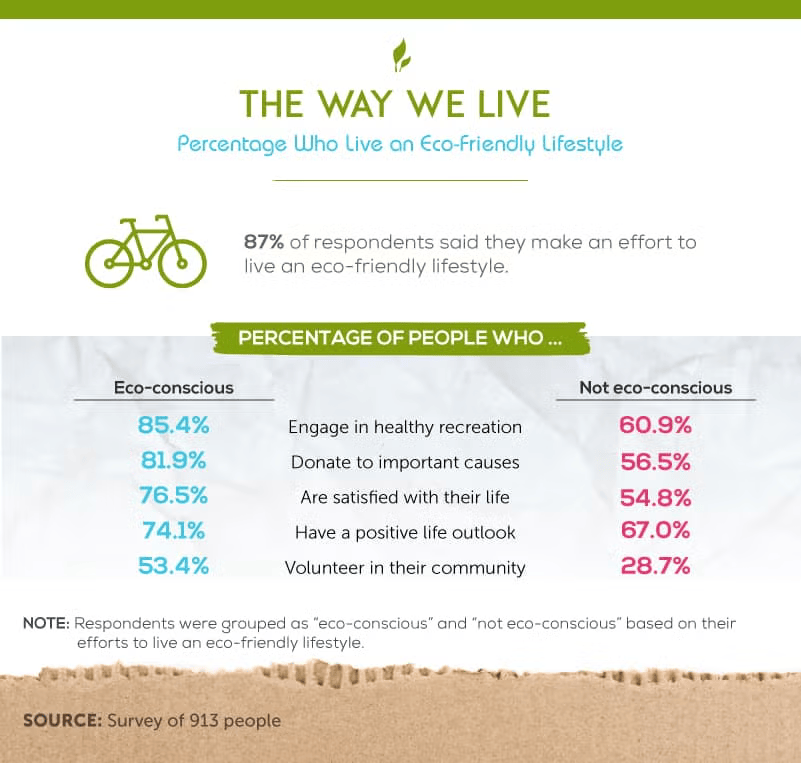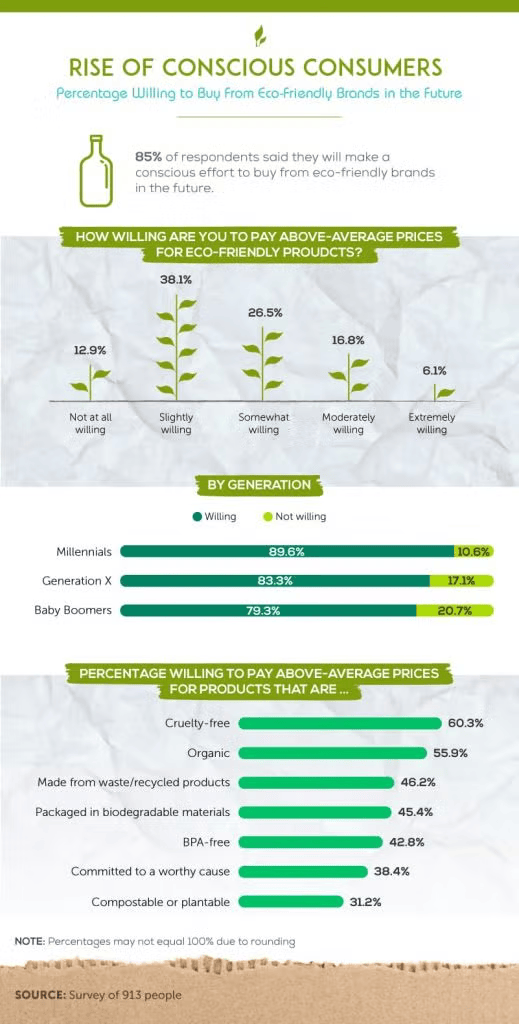From schools to businesses and homes, environmental efforts and “going green” are somewhat commercialised.
Nevertheless, this effort often doesn’t translate into behaviours that are significant enough to make a permanent change. Plastic production continues to increase year on year, while the number of vehicles on the road grows and grows.
So just how concerned are we? And how far are we willing to go to protect the planet? We surveyed over 900 people across Australia and the U.S. to find out. Continue reading to see what the future may hold for Earth.
Part of the problem

It’s often hard to determine which environmental statistic is the most alarming. This year, air pollution will cause one of every eight deaths across the globe. An entire truckload of plastic enters our oceans every minute. Half of the world’s forests are completely gone.
So where does that leave us? Fortunately, there is hope, as awareness of the crisis spreads as well. Of the 913 people surveyed, 93% indicated a general concern for the environment. With any luck, this apprehension will soon translate into greener behaviour and begin to reverse some of the planetary damage.
Of the 913 surveyed, 79% were Americans and 21% were Australians. The Environmental Performance Index (EPI) of these two countries is relatively similar: Australia ranks 21st in the world, and the U.S. ranks 27th. Although they are not the worst countries in terms of environmental “scores,” they both share an enormous room for improvement and growth. Continue reading to see which specific environmental issues concerned our participants the most.
Issue by issue

Overall, the top environmental concern amongst the public was plastic pollution in the oceans. Globally, the oceans provide 70% of the planet’s oxygen, putting breathing at stake as well. Unfortunately, plastic pollution in the oceans poses an enormous threat by killing sea life, increasing ocean acidification, and reducing the amount of clean oxygen it produces.
More specifically, 44.4 percent of Australians felt their home was threatened by plastic pollution. This makes sense, as plastic production does represent an enormous threat to the Australian coastline, which contributes heavily to both their tourism and fishery industries. In addition to the moral implications of planetary destruction, Australia’s Great Barrier Reef has been valued at $56 billion, contributing $6.4 billion per year to their economy, while their commercial fishing industry earns $3.3 billion annually.
Interestingly, the concern of contaminated drinking water presented the largest differential in environmental concerns between Americans and Australians. This may have to do with many recent news stories and findings of contaminated drinking water, which concerned 37 percent of Americans, as opposed to just 27 percent of Australians.
Green aging

The awareness that our participants cited, however, was encouraging. Gen Xers cited more concern about plastic pollution than any other generation studied: 43% said it was their top environmental concern. For millennials, the top concern was the extinction of animal and plant species. Meanwhile, baby boomers (38%) were most concerned about climate change. Of course, many of these environmental issues go hand in hand.
Awareness and concern, however, are only a part of the solution. The majority of respondents – 79% – expected governmental authorities to tackle these issues. Because the crisis is so imminent, however, private citizens are taking matters into their own hands. Companies like 4Ocean in the U.S. and grassroots efforts like Take 3 for the Sea in Australia work tirelessly to solve the plastic crisis, affecting change on a global scale. Nevertheless, national governments need to play a crucial role in saving the planet, as both concern and damage continue to accumulate.

Walking the walk

Encouragingly, 87% of respondents said they made an effort to live an eco-friendly lifestyle. The even better news is that these greener choices led to deeper levels of life satisfaction.
Nearly 77% of eco-conscious consumers were satisfied with their life, compared to 54.8% of consumers who weren’t eco-conscious. Even if the environment doesn’t rank amongst your top concerns, your life satisfaction just might. Taking care of the planet evidently corresponds to taking care of yourself. Moreover, those who lived in eco-friendly ways were seven percentage points more likely to have a positive outlook on life.
The gap between consumers widened when it came to volunteering to help their local communities. Only 28.7% of consumers who weren’t eco-conscious chose to volunteer, compared to 53.4% of eco-conscious consumers. Greener participants were even more likely to engage in healthy recreation, which could influence their increased levels of life satisfaction as well.
Doing our part

Some eco-friendly habits are easier to adopt than others. Although plastic pollution was the number one concern amongst participants, only 45.2% of respondents avoided single-use plastics.
This may be because single-use plastic is so heavily woven into our everyday lives. In fact, this was cited as the most difficult eco-friendly behaviour amongst participants. From shampoo bottles to tomato sauce containers and coffee cups, there’s almost a complete lifestyle overhaul that has to occur to be completely plastic-free. Only 18% of our respondents brought their own cups to coffee shops. That said, there are many ways to eliminate plastic from your life without majorly shifting your lifestyle.
The most common eco-friendly habit amongst respondents was recycling. Over 83% claimed to recycle. That said, China has recently stopped accepting foreign recycling, leaving much of what goes into the recycling bin dumped into landfills. Although recycling is still better than throwing something in the trash, it’s important to limit your trash intake in the first place. Remember the mantra, “Refuse, Reduce, Reuse, Recycle,” and take steps where possible.
Why we care

Above all, respondents hoped to leave a better planet for their children. For 72% of participants, this was their number one motivating factor for protecting the Earth. Just after children, however, was plastic with 71.1% citing plastic pollution in the oceans as a primary reason for wanting to be environmentally friendly.
These motivations, however, were not without roadblocks. Almost 83% of people saw the high costs of eco-friendly products as a barrier to a greener lifestyle. While some eco-friendly brands do have higher price points, this study will later reveal this generalisation as a very common misconception.
Another 51.6% of participants also noted inconvenience as a barrier to environmentalism, which may be more valid. “Throwaway living,” as it was once advertised, has become so normalised that there is a certain degree of inconvenience associated with changing behaviour. Nevertheless, the environmental crisis dictates the necessity of greener ways of living – it just may take some getting used to.
Growing conscious

Moving forward, 85% of participants said they would make a conscious effort to buy from eco-friendly brands in the future. Whether this refers to switching brands or finding reusable alternatives, it’s encouraging to see such a high percentage of people looking to improve the planet.
As far as payment went, over 87% were willing to pay above-average prices for eco-friendly products to some degree, although that isn’t always necessary. Millennials (nearly 90%) were more willing than Gen Xers and baby boomers to spend more. However, even around 80% of baby boomers claimed they would pay more for greener products.
Willingness to go green varied by product discussed. Cruelty-free products, or products that do not inflict harm on animals, were the most likely to cause participants to accept higher prices. Almost 56% were also motivated to spend more if the product was organic. Compostable and plantable products were the least likely to cause people to increase their spending, as only 31.2% said labels like these would make them pay more.
Green life contents

Most respondents reported already owning at least one eco-friendly product. The most common? Reusable grocery bags. Sixty-one percent of respondents had a bag they brought with them to the grocery store. A reusable tote has an estimated life span equivalent to 700 single-use plastic bags. Although this pales compared to the roughly 1.8 billion single-use plastic bags that are discarded every week, it’s important to take steps when you can as opposed to giving up when the problem cannot be solved immediately. Also important to note is that Australians were nearly 37 percentage points more likely than Americans to own reusable or paper grocery bags.
Compact fluorescent lightbulbs and reusable water bottles were common as well, with 59.7% and 53.9% of respondents owning them, respectively. For added perspective, know that over 60 million plastic bottles make their way to landfills every day. Fortunately, reusable bottles are easy to find and can help people save money in the long run. Some prominent brands like Starbucks offer discounts for their use as well. Again, Australians were more likely than Americans to own a reusable water bottle.
The least common eco-friendly product found in participants’ homes were zero-waste shampoo and conditioner. Even in greener stores like Whole Foods, eco-friendly shower products are often hard to find, making the switch all the more difficult. Fortunately, eco-friendly markets where consumers can refill their shampoo bottles are becoming more and more common, so the convenience factor may soon be improved.
Boycotting brands

Eco-friendly purchases exist in two fashions: buying the right brands and avoiding the wrong ones. Fifty-one percent of respondents said they stopped buying from brands they perceived as harmful to the environment. That said, certain aspects of the eco-friendly lifestyle were more likely to compel consumers to make these types of purchases.
Animal testing and cruelty were the most cited deterrents to buying non-green products. Pollution was also cited 70.8% of the time as a reason to avoid certain products and brands. Palm oil, which is said to be responsible for 8% of the world’s deforestation, was unlikely to dramatically shift consumer behaviour, as only 33.4% of respondents said its use would make them buy an eco-friendly alternative.

Similarly to participant desire for government action, corporations are also expected to take on environmental issues. Companies like Nestle have been on the receiving end of intense protests in response to their plastic production, having produced 1.7 million tons of plastic in 2018. Moreover, only 100 companies are thought to be responsible for 71% of the world’s global greenhouse gas emissions. With statistics like these, the role corporations must play becomes increasingly obvious.
Misguided sustainability

Another great barrier to environmentally friendly behavior is the difficulty of dispersing accurate information. More than half of our respondents were misguided in at least one green area. Most commonly, 61.6% of people believed an eco-friendly lifestyle was more expensive. While there are certain eco-friendly brands that do incur higher costs, there are more eco-friendly practices and products that can help save money. For instance, the heating and cooling of your home can consume roughly half of your annual energy bill, which certain tricks can help. Using washable rags as opposed to paper towels can dramatically impact your grocery bill. Buying a reusable cup can help you save money by reducing the amount you spend on plastic bottles.
The second biggest misconception, believed by 25.3% of respondents, was food products labelled as “natural” were backed by meaningful standards. This refers to greenwashing, wherein corporations use conscious consumerism to their marketing advantage without actually making a real effort to improve their practices. Unfortunately, the research burden is often placed on consumers to find truly green products.
Moving forward with going green
On the bright side, a lack of education is a completely solvable problem. Seventy-seven percent of respondents demonstrated an interest in learning how to lead a more sustainable lifestyle, while another 72% wanted to learn about humanity’s impact on the environment.
Southern Cross University is a leader in this space. The latest Excellence in Research for Australia (ERA) report listed SCU as “well above world standard” in areas of Earth Science, Oceanography, Environmental Science and Management, among others.
The decision to ‘go green’ of course takes a considerable amount of effort and consistency. The decision is hard enough for an individual to implement positive changes, but this only gets amplified when it comes to influencing others to make a positive impact on a larger scale.
As a pioneer in delivering online education SCU offers several fully online courses, such as the MBA, that develop the leadership traits and management skills needed for fostering such a change in your company, community and world. In addition, studying 100% online could be seen as a mode with the least impact on the environment. Saving you the commute to campus and limiting the use of printed materials and textbooks.
Methodology and limitations
For this study, we gathered 913 respondents by administering online surveys to respondents in the United States and Australia. 20.7% of the sample was from Australia, and 79.3% identified as American. Additionally, the sample included 442 women, 469 men, and six participants identifying as neither male nor female. The median age of the group surveyed was 32 years old.
To ensure data quality and accuracy, an attention-check question was used to filter respondents entering inconsistent or faulty data. An “eco-conscious” respondent was considered as any participant who made an effort to live an eco-friendly lifestyle. Inversely, a respondent was considered “not eco-conscious” if they didn’t lead an eco-friendly lifestyle. Environmental concern was assessed using the “General Environmental Concern Scale” items described in Alwitt, Linda F., and Pitts, Robert E. (1996), and life satisfaction measures were evaluated using a custom Likert scale. The prevalent environmental issues were collated using several credible sources and were presented based on respondents’ level of concern.
These data were collected via a self-reported survey built on SurveyMonkey and hosted on Prolific.ac for Australian participants and Amazon’s Mechanical Turk for American participants. Self-reported data are often limited in their accuracy due to a range of issues, which may include but aren’t limited to the following: respondents’ tendencies to exaggerate, attribute, portray themselves in a good light, or answer questions based on their perceptions of social desirability bias.
Sources:
- https://www.latimes.com/business/autos/la-fi-hy-ihs-automotive-average-age-car-20140609-story.html
- https://www.greenpeace.org/usa/key-facts-about-plastic-pollution/
- https://epi.envirocenter.yale.edu/2018/report/category/
- https://theconversation.com/whats-the-economic-value-of-the-great-barrier-reef-its-priceless-80061
- http://data.daff.gov.au/data/warehouse/9aam/afstad9aamd003/2016/AustFishAquacStats_2016_v1.0.0.pdf
- https://www.cbsnews.com/news/drinking-water-may-contain-pfas-chemicals-in-43-states-according-to-new-study-by-environmental-working-group/
- https://www.nationalgeographic.org/activity/save-the-plankton-breathefreely/
- https://4ocean.com/gclid=CjwKCAjwzPXlBRAjEiwAj_XTEdElgkAs5RDRvURJMdzBMVNTVEVwuXQfIkcNuDUXHtVHaaPcnRxu2xoCoRAQAvD_BwE
- https://www.take3.org/
- https://myplasticfreelife.com/plasticfreeguide/
- https://www.nytimes.com/2018/05/29/climate/recycling-landfills-plastic-papers.html
- https://www.plasticpollutioncoalition.org/the-4-rs
- https://www.instagram.com/p/Bvjl7oYFU6A/
- https://www.reusethisbag.com/articles/25-reasons-to-go-reusable/
- http://www.container-recycling.org/index.php/issues/…/275-down-the-drain
- http://www.isustainableearth.com/green-products/reusable-water-bottles-help-you-go-green-and-stay-healthy
- https://www.starbucks.com/responsibility/global-report/environmental-stewardship/reusable-cups
- https://www.nbcmiami.com/news/local/Reduce-Reuse-Recycle—And-Refill-Eco-Friendly-Bulk-Market-Verde-Comes-to-Miami-489229401.html
- https://www.bbc.co.uk/newsround/39492207
- https://www.greenpeace.org/international/press-release/21754/greenpeace-nestle-annual-general-meeting-end-plastic-pollution/
- https://www.theguardian.com/sustainable-business/2017/jul/10/100-fossil-fuel-companies-investors-responsible-71-global-emissions-cdp-study-climate-change
- https://www.thepennyhoarder.com/smart-money/how-to-go-green/
- https://foodrevolution.org/blog/how-to-avoid-greenwashing/
- https://dataportal.arc.gov.au/ERA/NationalReport/2018/
- https://www.scu.edu.au/research/our-research/era/
Fair use statement
Sharing information is an important first step in stopping the environmental crisis. Feel free to spread this message far and wide for non-commercial purposes, so long as you link back to this page and its authors so that they can receive proper credit for their work.





